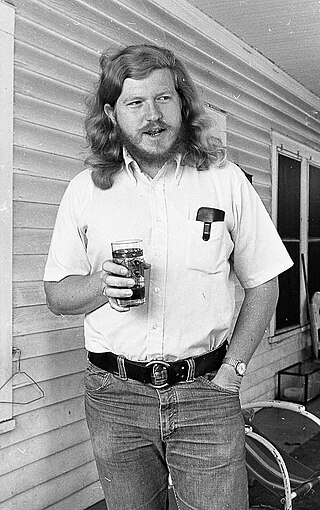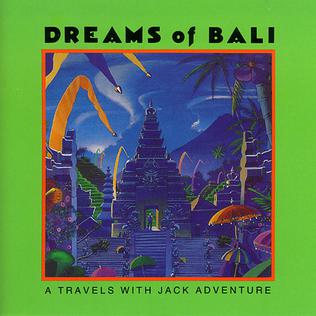
Skeleton Crew is a collection of short fiction by American writer Stephen King, published by Putnam in June 1985. A limited edition of a thousand copies was published by Scream/Press in October 1985 (ISBN 978-0910489126), illustrated by J. K. Potter, containing an additional short story, "The Revelations of 'Becka Paulson", which had originally appeared in Rolling Stone magazine, and was later incorporated into King's 1987 novel The Tommyknockers. The original title of this book was Night Moves.

Binaural recording is a method of recording sound that uses two microphones, arranged with the intent to create a 3-D stereo sound sensation for the listener of actually being in the room with the performers or instruments. This effect is often created using a technique known as dummy head recording, wherein a mannequin head is fitted with a microphone in each ear. Binaural recording is intended for replay using headphones and will not translate properly over stereo speakers. This idea of a three-dimensional or "internal" form of sound has also translated into useful advancement of technology in many things such as stethoscopes creating "in-head" acoustics and IMAX movies being able to create a three-dimensional acoustic experience.

Headphones are a pair of small loudspeaker drivers worn on or around the head over a user's ears. They are electroacoustic transducers, which convert an electrical signal to a corresponding sound. Headphones let a single user listen to an audio source privately, in contrast to a loudspeaker, which emits sound into the open air for anyone nearby to hear. Headphones are also known as earphones or, colloquially, cans. Circumaural and supra-aural headphones use a band over the top of the head to hold the speakers in place. Another type, known as earbuds or earpieces consist of individual units that plug into the user's ear canal. A third type are bone conduction headphones, which typically wrap around the back of the head and rest in front of the ear canal, leaving the ear canal open. In the context of telecommunication, a headset is a combination of headphone and microphone.

The Black Mass was a horror-fantasy radio drama produced by Erik Bauersfeld, a leading American radio dramatist of the post-television era. The series aired on KPFA (Berkeley) and KPFK from 1963 to 1967, on an irregular schedule. Bauersfeld was the Director of Drama and Literature at KPFA from 1966 to 1991.

Karl Edward Wagner was an American writer, poet, editor, and publisher of horror, science fiction, and heroic fantasy, who was born in Knoxville, Tennessee and originally trained as a psychiatrist. He wrote numerous dark fantasy and horror stories. As an editor, he created a three-volume set of Robert E. Howard's Conan the Barbarian fiction restored to its original form as written, and edited the long-running and genre-defining The Year's Best Horror Stories series for DAW Books. His Carcosa publishing company issued four volumes of the best stories by some of the major authors of the so-called Golden Age pulp magazines. He is possibly best known for his creation of a series of stories featuring the character Kane, the Mystic Swordsman.
ZBS Foundation, a small non-profit audio production company, was founded by Thomas Lopez in 1970 with a grant from Robert E. Durand as a working commune, located on a donated farm in Upstate New York. ZBS stands for "Zero Bull Shit". The commune's purpose was to raise consciousness through media, specifically full-cast audio dramas. The foundation is "one of the most prolific producers of contemporary radio drama."

Stereophonic sound, or more commonly stereo, is a method of sound reproduction that recreates a multi-directional, 3-dimensional audible perspective. This is usually achieved by using two independent audio channels through a configuration of two loudspeakers in such a way as to create the impression of sound heard from various directions, as in natural hearing.
In acoustics, the dummy head recording is a method of recording used to generate binaural recordings. The tracks are then listened to through headphones allowing for the listener to hear from the dummy’s perspective. The dummy head is designed to record multiple sounds at the same time enabling it to be exceptional at recording music as well as in other industries where multiple sound sources are involved.
The Fourth Tower of Inverness is a 1972 radio drama, produced by the ZBS Foundation. It is the first of the Jack Flanders adventure series, and combines elements of American culture and Old-time radio, with metaphysical concepts such as past life regression, Sufi wisdom, Tibetan Buddhism and shamanistic communication with the natural world.
Thomas Lopez, aka Meatball Fulton, is president of the ZBS Foundation and one of the foundation's founders. He writes and produces the ZBS Foundation's audio drama productions. When he was working in radio in the 1960s, Lopez took "Meatball Fulton" out of Rolling Stone as his nom de plume.
Ruby the Galactic Gumshoe is a science fiction radio drama series by the ZBS Foundation, written by Thomas Lopez. The first series, Ruby: Adventures of A Galactic Gumshoe, was created in 1982. In each story, the title character Ruby is hired to solve a metaphysical problem. New series have been released every few years, reaching Ruby 11 in 2023. Ruby is played by actress Laura Esterman.
"Sticks" is a short story by horror fiction writer Karl Edward Wagner, first published in the March 1974 issue of Whispers. It has been reprinted in several anthologies, including the revised edition of Tales of the Cthulhu Mythos, indicating that it is part of the Cthulhu Mythos genre.

Moon Over Morocco is a 1974 radio drama, the second in ZBS's Jack Flanders series. Originally broadcast as fifty twelve-minute episodes, the serial was written and directed by Meatball Fulton.
Ambiophonics is a method in the public domain that employs digital signal processing (DSP) and two loudspeakers directly in front of the listener in order to improve reproduction of stereophonic and 5.1 surround sound for music, movies, and games in home theaters, gaming PCs, workstations, or studio monitoring applications. First implemented using mechanical means in 1986, today a number of hardware and VST plug-in makers offer Ambiophonic DSP. Ambiophonics eliminates crosstalk inherent in the conventional stereo triangle speaker placement, and thereby generates a speaker-binaural soundfield that emulates headphone-binaural sound, and creates for the listener improved perception of reality of recorded auditory scenes. A second speaker pair can be added in back in order to enable 360° surround sound reproduction. Additional surround speakers may be used for hall ambience, including height, if desired.

Dreams of Rio is a radio drama, produced by the ZBS Foundation. It is the fifth of the Jack Flanders adventure series, and combines elements of American culture and Old-time radio with themes of lost cities, jungle exploration and shamanism. It immediately precedes but is not part of the "Travels with Jack" adventures, each of which is entitled Dreams of ...

Dreams of the Amazon is a radio drama, produced by the ZBS Foundation. It is the sixth of the Jack Flanders adventure series and the first of the Travels with Jack sub-series. It combines elements of American culture and Old-time radio with themes of lost cities, jungle exploration and shamanism. It is a loose sequel to Dreams of Rio and while it is not necessary to have heard that story first it will help to understand some of the references.

Dreams of Bali is a radio drama, produced by the ZBS Foundation. It is the eight of the Jack Flanders adventure series and the third of the Travels with Jack sub-series. It combines elements of American culture, Old-time radio and Sufism.

The Mystery of Jaguar Reef is a radio drama, produced in 1996 by the ZBS Foundation. It is the tenth of the Jack Flanders adventure series. It combines elements of American culture and Old-time radio with themes of pirates and aliens.
The White Castle is a radio drama, produced by the ZBS Foundation. It is the twentieth of the Jack Flanders adventure series and the fourth of The Fantastic Voyages of Captain Jack Flanders sub-series. It combines elements of old-time radio with psychic phenomena, supernatural beings and energies.

Autonomous sensory meridian response (ASMR) is a tingling sensation that usually begins on the scalp and moves down the back of the neck and upper spine. A pleasant form of paresthesia, it has been compared with auditory-tactile synesthesia and may overlap with frisson.












